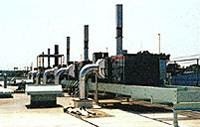Rubber Curing Emissions
Comments Off on Rubber Curing EmissionsThe Challenge
 A rubber vulcanization company was looking for a new, affordable abatement solution to treat their blue haze and low-level Volatile Organic Compounds (VOCs) in order to meet regulatory requirements. The large Electrostatic Precipitator (ESP) in use was extremely expensive to operate and maintain. The company began their search for a system that offered effective opacity control and could also reduce operating costs. The air pollution control supplier would need the ability to engineer the optimum solution and have the product breadth necessary to apply the correct technology.
A rubber vulcanization company was looking for a new, affordable abatement solution to treat their blue haze and low-level Volatile Organic Compounds (VOCs) in order to meet regulatory requirements. The large Electrostatic Precipitator (ESP) in use was extremely expensive to operate and maintain. The company began their search for a system that offered effective opacity control and could also reduce operating costs. The air pollution control supplier would need the ability to engineer the optimum solution and have the product breadth necessary to apply the correct technology.
The Solution
After thorough technical evaluation, the plant selected Anguil Environmental to solve their VOC emission problem and put them in compliance. Anguil installed its patented Self-Cleaning Ceramic Filter (SCCF) to eliminate the blue haze and the VOCs.
 The Result
The Result
In order to alleviate the maintenance headaches of their ESP, the owner inquired about a thermal oxidizer. However, the fuel costs of a thermal system are almost equal to the maintenance cost of an ESP for this application. Because of its fuel efficiency and lower operating costs, the Regenerative Thermal Oxidizer (RTO) was a possible option but Anguil found that the footprint and the weight of the unit could not provide the flexibility the customer desired. Anguil’s engineers concluded that an SCCF was the most effective solution.
One of the major considerations in designing a treatment system for a rubber curing process is that the ducts must be kept clean from any particulate buildup. Large treatment systems, like an ESP or RTO, also involve long duct runs. This combination makes many treatment solutions both costly and dangerous, since particulate buildup can cause duct fires.
Anguil worked with the customer and their process engineers to design a solution that greatly reduced duct maintenance cost and provided effective opacity and VOC control. The small footprint of multiple SCCFs allowed Anguil to roof-mount the units and treat 1,500 SCFM (2,407.5 Nm3/hr) over each of the oven “zones” with direct duct runs. By making shorter and more direct duct runs, Anguil engineers reduced the risk and associated costs of particulate buildup.
Added benefits of the Anguil SCCF include a 40% effective shell and tube heat exchanger, providing even greater cost savings through heat recovery. Anguil’s flexibility also provides options for future adjustments in pollution control. Because the plant was located in an area that may come under more stringent environmental regulations, Anguil’s SCCF can be equipped with catalyst to achieve greater than 95% VOC destruction.
After a successful SCCF pilot, Anguil’s engineers worked with the customer to provide the most effective and lowest-cost operating system. Flexibility, experience and constant pursuit of better design resulted in another satisfied Anguil customer.

